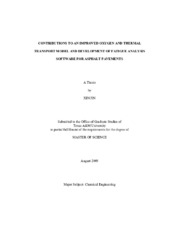| dc.description.abstract | Fatigue cracking is one primary distress in asphalt pavements, dominant
especially in later years of service. Prediction of mixture fatigue resistance is critical for
various applications, e.g., pavement design and preventative maintenance. The goal of
this work was to develop a tool for prediction of binder aging level and mixture fatigue
life in pavement from unaged binder/mixture properties. To fulfill this goal, binder
oxidation during the early fast-rate period must be understood. In addition, a better
hourly air temperature model is required to provide accurate input for the pavement
temperature prediction model. Furthermore, a user-friendly software needs to be
developed to incorporate these findings.
Experiments were conducted to study the carbonyl group formation in one
unmodified binder (SEM 64-22) and one polymer-modified binder (SEM 70-22), aged at
five elevated temperatures. Data of SEM 64-22, especially at low temperatures, showed
support for a parallel-reaction model, one first order reaction and one zero order
reaction. The model did not fit data of SEM 70-22. The polymer modification of SEM 70-22 might be responsible for this discrepancy. Nonetheless, more data are required to
draw a conclusion.
Binder oxidation rate is highly temperature dependent. Hourly air temperature
data are required as input for the pavement temperature prediction model. Herein a new
pattern-based air temperature model was developed to estimate hourly data from daily
data. The pattern is obtained from time series analysis of measured data. The new model
yields consistently better results than the conventional sinusoidal model.
The pavement aging and fatigue analysis (PAFA) software developed herein
synthesizes new findings from this work and constant-rate binder oxidation and
hardening kinetics and calibrated mechanistic approach with surface energy (CMSE)
fatigue analysis algorithm from literature. Input data include reaction kinetics
parameters, mixture test results, and pavement temperature. Carbonyl area growth,
dynamic shear rheometer (DSR) function hardening, and mixture fatigue life decline are
predicted as function of time. Results are plotted and saved in spreadsheets. | en |


